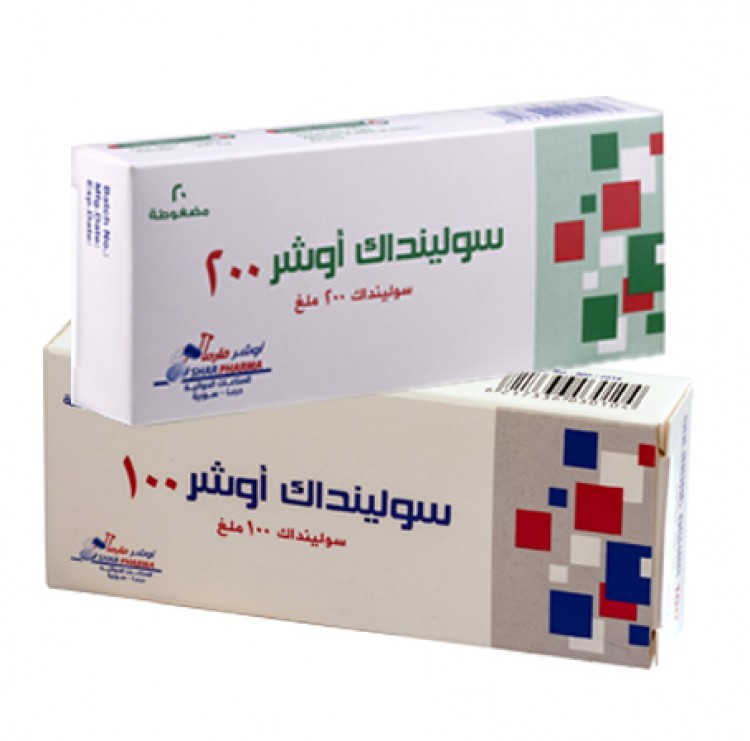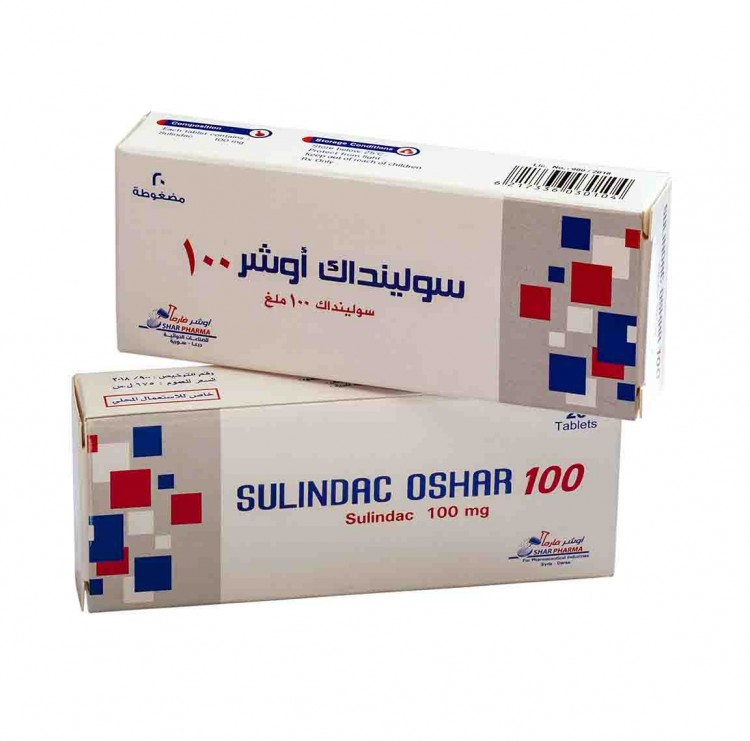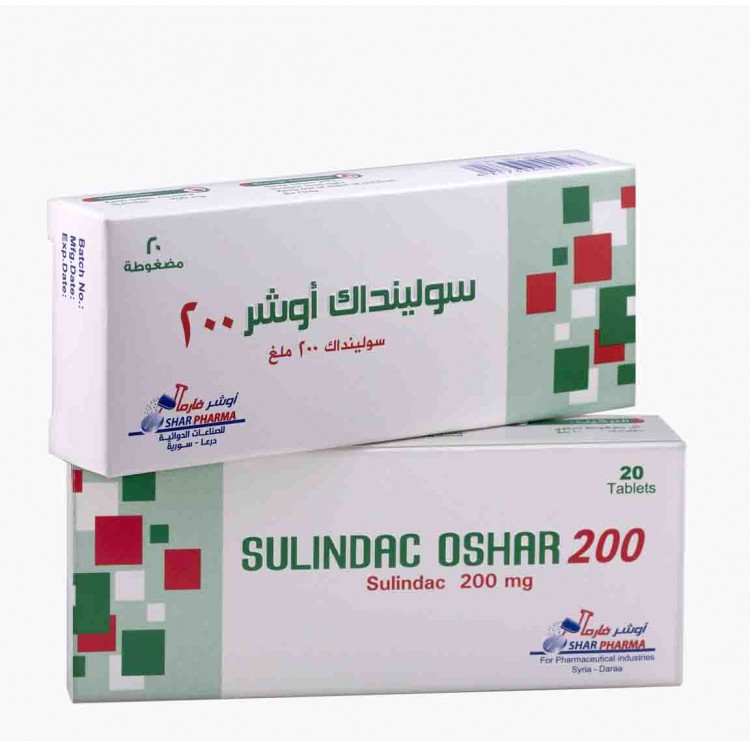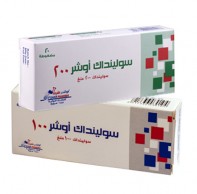Sulindac oshar ( 100mg - 200mg ) Tablets
Sulindac is a non-steroidal anti-inflammatory drug (NSAID) that exhibits anti-inflammatory, analgesic and antipyretic activities in animal models. The mechanism of action, like that of other NSAIDs, is not completely understood but may be related to prostaglandin synthesis inhibition.
Composition
Each tablet contains 100 mg or 200 mg Sulindac
Excipients: microcrystalline cellulose, maize starch , magnesium stearate
Usage
Sulindac is indicated for acute or long-term use in the relief of signs and symptoms of the following:
-1 Osteoarthritis.
-2 Rheumatoid arthritis.
-3 Ankylosing spondylitis.
-4 Acute painful shoulder.
-5 Acute gouty arthritis.
CONTRAINDICATIONS:
• Sulindac is contraindicated in patients with known hypersensitivity to sulindac or the excipients .
• Sulindac should not be given to patients who have experienced asthma, urticaria, or allergic-type reactions after taking aspirin or other NSAIDs. Severe, rarely fatal, anaphylactic/anaphylactoid reactions to NSAIDs have been reported in such patients .
• Severe hepatic, renal and cardiac failure .
• During the last trimester of pregnancy .
• Active or history of recurrent peptic ulcer/haemorrhage (two or more distinct episodes of proven ulceration or bleeding).
• History of gastrointestinal bleeding or perforation, related to previous NSAIDs therapy.
• Use with concomitant NSAIDs including cyclooxygenase 2 specific inhibitors.
• Sulindac is contraindicated in the setting of coronary artery bypass graft (CABG) surgery.
Side Effects
• Sulindac is contraindicated in patients with known hypersensitivity to sulindac or the excipients .
• Sulindac should not be given to patients who have experienced asthma, urticaria, or allergic-type reactions after taking aspirin or other NSAIDs. Severe, rarely fatal, anaphylactic/anaphylactoid reactions to NSAIDs have been reported in such patients .
• Severe hepatic, renal and cardiac failure .
• During the last trimester of pregnancy .
• Active or history of recurrent peptic ulcer/haemorrhage (two or more distinct episodes of proven ulceration or bleeding).
• History of gastrointestinal bleeding or perforation, related to previous NSAIDs therapy.
• Use with concomitant NSAIDs including cyclooxygenase 2 specific inhibitors.
• Sulindac is contraindicated in the setting of coronary artery bypass graft (CABG) surgery.
| Properties |
Pharmacokinetic properties:
Absorption:
Sulindac is incompletely absorbed from the gastro-intestinal tract. Peak plasma concentrations of the sulphide metabolite are achieved in about 2 to 4 hours. The mean half-life of sulindac is about 7 to 8 hours and of the sulphide metabolite about 16 to 18 hours.
Distribution :
Sulindac, and its sulfone and sulfide metabolites, are 93.1,e 95.4, and 97.9 % bound to plasma proteins, predominantly to albumin.
Metabolism:
Sulindac undergoes two major biotransformations of its sulfoxide moiety: oxidation to the inactive sulfone and reduction to the pharmacologically active sulfide
Elimination:
Approximately 50 % of the administered dose of sulindac is excreted in the urine with the conjugated sulfone metabolite accounting for the major portion. Less than 1 % of the administered dose of sulindac appears in the urine as the sulfide metabolite. Approximately %25 is found in the feces, primarily as the sulfone and sulfide metabolites.
|
|---|---|
| Dosage |
DOSAGE AND ADMINISTRATION:
Sulindac Tablets should be administered orally twice a day with food. The maximum dosage is 400 mg per day. Dosages above 400 mg per day are not recommended.
In osteoarthritis, rheumatoid arthritis, and ankylosing spondylitis, the recommended starting dosage is 150 mg twice a day. The dosage may be lowered or raised depending on the response.
A prompt response (within one week) can be expected in about one-half of patients with osteoarthritis, ankylosing spondylitis, and rheumatoid arthritis. Others may require longer to respond.
In acute painful shoulder (acute subacromial bursitis/supraspinatus tendinitis) and acute gouty arthritis, the recommended dosage is 200 mg twice a day. After a satisfactory response has been achieved, the dosage may be reduced according to the response. In acute painful shoulder, therapy for 14-7 days is usually adequate. In acute gouty arthritis, therapy for 7 days is usually adequate.
OVERDOSAGE:
Symptoms:
stupor, coma, diminished urine output and hypotension
Therapeutic measure:
In the event of overdosage, the stomach should be emptied by inducing vomiting or by gastric lavage, and the patient carefully observed and given symptomatic and supportive treatment.
|
| Drug interactions |
DRUG INTERACTION:
ACE-Inhibitors and Angiotensin II Antagonists:
the co-administration of an NSAID and an ACE-inhibitor or an angiotensin II antagonist may result in further deterioration of renal function, including possible acute renal failure, which is usually reversible. Therefore, monitor renal function periodically in patients receiving ACEIs or AIIAs and NSAIDs in combination therapy.
Aspirin:
The concomitant administration of aspirin with sulindac significantly depressed the plasma levels of the active sulfide metabolite . Since the addition of aspirin did not have a favorable effect on the therapeutic response to sulindac, the combination is not recommended.
Cyclosporine:
Administration of non-steroidal anti-inflammatory drugs concomitantly with cyclosporine has been associated with an increase in cyclosporine-induced toxicity, possibly due to decreased synthesis of renal prostacyclin. NSAIDs should be used with caution in patients taking cyclosporine, and renal function should be carefully monitored.
Diflunisal:
The concomitant administration of sulindac and diflunisal in normal volunteers resulted in lowering of the plasma levels of the active sulindac sulfide metabolite by approximately one-third.
Diuretics:
The sulindac can reduce the natriuretic effect of furosemide and thiazides in some patients. This response
has been attributed to inhibition of renal prostaglandin synthesis. During concomitant therapy with NSAIDs, the patient should be observed closely for signs of renal failure , as well as to assure diuretic efficacy.
DMSO:
DMSO should not be used with sulindac. Concomitant administration has been reported to reduce the plasma levels of the active sulfide metabolite and potentially reduce efficacy. In addition, this combination has been reported to cause peripheral neuropathy.
Lithium:
NSAIDs have produced an elevation of plasma lithium levels and a reduction in renal lithium clearance. The mean minimum lithium concentration increased 15% and the renal clearance was decreased by
approximately 20%. These effects have been attributed to inhibition of renal prostaglandin synthesis by the NSAID. Thus, when NSAIDs and lithium are administered concurrently, subjects should be observed carefully for signs of lithium toxicity.
Methotrexate:
NSAIDs have been reported to competitively inhibit methotrexate accumulation in rabbit kidney slices. This may indicate that they could enhance the toxicity of methotrexate. Caution should be used when NSAIDs are administered concomitantly with methotrexate.
NSAIDs:
The concomitant use of sulindac with other NSAIDs is not recommended due to the increased possibility of gastrointestinal toxicity, with little or no increase in efficacy.
Oral anticoagulants:
Special attention should be paid to patients taking higher doses than those recommended and to patients with renal impairment or other metabolic defects that might increase sulindac blood levels. The effects of warfarin and NSAIDs on GI bleeding are synergistic, such that users of both drugs together have a risk of serious GI bleeding higher than users of either drug alone.
Oral hypoglycemic agents:
patients should be monitored carefully until it is certain that no change in their hypoglycemic dosage is required. Special attention should be paid to patients taking higher doses than those recommended and to patients with renal impairment or other metabolic defects that might increase sulindac blood levels.
Probenecid:
Probenecid given concomitantly with sulindac had only a slight effect on plasma sulfide levels, while plasma levels of sulindac and sulfone were increased. Sulindac was shown to produce a modest reduction in the uricosuric action of probenecid, which probably is not significant under most circumstances.
|
| precautions and precautions |
WARNINGS & PRECAUTIONS:
Cardiovascular Thrombotic Events:
To minimize the potential risk of an adverse CV events in NSAID-treated patients, use the lowest effective dose for the shortest duration possible. Physicians and patients should remain alert for the development of such events, throughout the entire treatment course, even in the absence of previous CV symptoms. Patients should be informed about the symptoms of serious CV events and the steps to take if they occur.
There is no consistent evidence that concurrent use of aspirin mitigates the increased risk of serious CV thrombotic events associated with NSAID use. The concurrent use of aspirin and an NSAID, such as sulindac, increases the risk of serious gastrointestinal (GI) events .
Status Post Coronary Artery Bypass Graft (CABG) Surgery:
Two large, controlled clinical trials of a COX-2 selective NSAID for the treatment of pain in the first 10-14 days following CABG surgery found an increased incidence of myocardial infarction and stroke. NSAIDs are contraindicated in the setting of CABG
Post-MI Patients:
Avoid the use of sulindac tablets, in patients with recent MI unless the benefits are expected to outweigh the risk of recurrent CV thrombotic events. If sulindac tablets are used in patients with a recent MI, monitor patients for signs of cardiac ischemia
Hypertension:
NSAIDs, including sulindac, can lead to onset of new hypertension or worsening of pre-existing hypertension, either of which may contribute to the increased incidence of CV events. Patients taking thiazides or loop diuretics may have impaired response to these therapies when taking NSAIDs. NSAIDs,
|
| Package |
PACKAGING: a carton box contains 20 tablets
STORAGE CONDITIONS: Store below 25 °C , protect from light.
|




